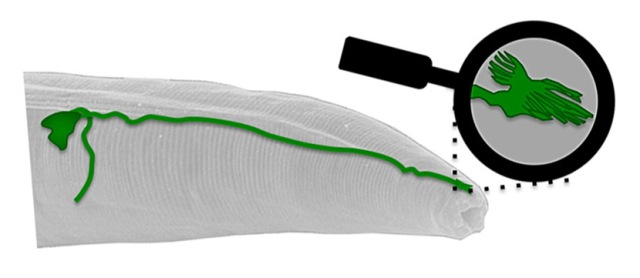A research team from the University of Texas, Austin, has discovered a magnetic field sensor in an animal for the first time. The identification of the sensor in the brain of a tiny worm called C. elegans may solve the long-standing mystery on the functioning of animals’ internal compasses.
 Inside the head of the worm C. elegans, the TV antenna-like structure at the tip of the AFD neuron (green) is the first identified sensor for Earth’s magnetic field. (Credit: Andrés Vidal-Gadea)
Inside the head of the worm C. elegans, the TV antenna-like structure at the tip of the AFD neuron (green) is the first identified sensor for Earth’s magnetic field. (Credit: Andrés Vidal-Gadea)
A wide range of animals, including wolves, sea turtles and migrating geese, navigate based on the Earth's magnetic field. However, it has not been clear how the animals are able to navigate. The sensor in C. elegans is a microscopic structure observed at the end of a neuron that is probably seen in animals with similarities in brain structure across species. The sensor is similar to a nano-scale TV antenna, and the worms make use of it to navigate underground.
"Chances are that the same molecules will be used by cuter animals like butterflies and birds. This gives us a first foothold in understanding magnetosensation in other animals," said Jon Pierce-Shimomura, assistant professor of neuroscience in the College of Natural Sciences and member of the research team.
The researchers sourced worms from several parts of the world, and analysed their movement in gelatin-filled tubes in search for food. Interestingly, worms outside of their home country still moved at the angle that would have corresponded to downwards. For example, worms from Australia moved in an upwards direction. This demonstrates that each individual worm's magnetic field sensor system is in line with its local environment, meaning they can differentiate between moving upwards or downwards.
The lead author of the research is Andrés Vidal-Gadea, a former postdoctoral researcher in the College of Natural Sciences at UT Austin, who is now a faculty member at Illinois State University. According to him, C. elegans is one of the diverse species present in the soil and most of them are known to migrate vertically.
"I'm fascinated by the prospect that magnetic detection could be widespread across soil dwelling organisms," said Vidal-Gadea.
The ability of C. elegans to sense humidity was already discovered by the neuroscientists and engineers who used these worms for the research on Alzheimer’s disease. This inspired them to research on the worm's ability to sense magnetic fields.
In 2012, Baylor College of Medicine scientists reported the discovery of brain cells in pigeons that process magnetic field information. However, they were not able to identify which part of the pigeon's body can sense the magnetic field. The team and other researchers suggested the presence of a magnetosensor in the inner ear of the pigeon.
"It's been a competitive race to find the first magnetosensory neuron. And we think we've won with worms, which is a big surprise because no one suspected that worms could sense the Earth's magnetic field," said Pierce-Shimomura.
The neuron carrying a magnetic field sensor, called an AFD neuron, was previously known to detect temperature and carbon dioxide levels.
The researchers used a special magnetic coil system to vary the magnetic field around the worms to identify their magnetosensory abilities and observe their behavioral changes. The results showed that the genetically engineered worms with a broken AFD neuron failed to orient themselves up and down, like the normal worms. In addition, the researchers demonstrated the effect of magnetic field changes on the activation of AFD neuron using the calcium imaging technique.
Pierce-Shimomura concluded that this research holds promise in the manipulation of magnetic fields to prevent damage of agricultural crops caused by harmful pests.
Other members of the research team include researchers from the College of Natural Sciences - Joshua Russell, a former graduate student who completed his Ph.D.; Kristi Ward, a former undergraduate; and Celia Beron, a current undergraduate. Research team members from the Cockrell School of Engineering are: Dr. Adela Ben-Yakar, associate professor of mechanical engineering; Navid Ghorashian, a former graduate student who completed his Ph.D.; and Sertan Gokce, a current graduate student.
The National Institutes of Health and the National Institute of Neurological Disorders and Stroke supported the research.